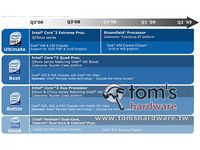Exclusive: 'Nehalem' at 2.9GHz and X58
In April this year, Intel announced a number of next generation products, including the 45-nanometer Nehalem micro-architecture and Tylersburg platform design. With the announcements came much talk about Intel’s upcoming X58 chipset, which at this time is still going through its initial sampling stages with motherboard manufacturers.
Today, we have the exclusive look at a full fledged X58 system. The new chipset will be the foundation
for Nehalem and Intel already indicated to us that the new platform will deliver a large boost in performance across all applications compared to currently available products.
With X58, end users will also start anew. Gone is the front-side bus, which is replaced by QuickPath on the X58. Those who are accustomed to overclocking their motherboards using the FSB, will have to start over and learn the new system. Similar to AMD’s HyperTransport, the QuickPath architecture will feature an integrated memory controller on the CPU and provide direct links between the CPU and system memory.
Intel will launch the X58 chipset with the same ICH-10 family of southbridges currently used on its P45 platform. ICH-10 supplies up to four PCI Express x16 paths, of which two, are PCI Express 2.0 paths. Other possible combinations are: one x16 path, two x16 paths, four x8 paths, and one 16 path and two x8 paths.Because of QuickPath however, we’re able to realize far better performance with wide bandwidth and very low latency. According to Intel, Nehalem will initially come with a 20-bit wide 25.6 GB/sec. QuickPath link, which gives a theoretical 2x performance increase in bandwidth over the 1600MHz FSB currently available on the X48 platform.
Memory support will come in the form of DD3 with support for 800MHz, 1066MHz and 1333MHz frequencies initially. Total bandwidth will be 32GB/sec. with support for up to 24GB of total system memory initially. X58 motherboards will provide up to 6 slots of memory but will require that the first slot (DIMM0) be populated.
Our sources indicated that Intel will release Bloomfield, the first of the Nehalem family at 3.2GHz, 2.93GHz and 2.66GHz and on an LGA1366-pin platform.
Get Tom's Hardware's best news and in-depth reviews, straight to your inbox.
Our test system used the 2.93GHz, but we can confirm that significantly higher clock frequencies are available.
On hand today, we have Foxconn’s Renaissance X58 motherboard. Foxconn’s board will be the a reference board for many others, with minor differences here and there. On the board, we find the X58 MCH and the ICH10-R south bridge. Power connections include a standard ATX connector as well as an 8-pin CPU power connector.
Other features of the board are ultra-low resistance, crystal, ferrite salt-core inductors, and solid ultra-low SR capacitors. This board in particular uses a six-phase power circuit design but we can expect other manufacturers to introduce variances in the power department.
The two blue PCIe slots on this board indicate that the slots are PCIe x16 2.0. There are also two black x16 1.0 slots. Other features include an Intelsil ISL6336 power management chip which supports the 6-phase switch power design, 2 FireWire IEEE 1394a ports provided by a TI TSB434B22A chip, and a Broadcom BCM5786KMLG chip for Gig-e support. Realtek’s ALC888S audio codec supports full 7.1 discrete analog output and optional Dolby Digital Live, DTS Connect, and Dolby Home Theater for real-time encoding of audio signals to an external processor or receiver.
The board also features vertical SATA connectors, although many manufacturers are now featuring angled slots for better cabling. Debugging LED lights and a clear CMOS button round out the rest of the board.
Speaking to other board manufacturers, X58 motherboards are about half-way through testing and validation and by the middle of this month, new revisions may be coming. Judging from what we were told, other board manufacturers already have board designs with features that are better than the Foxconn board we briefly looked at today. This isn’t really a problem since the board we looked at today is a typical reference design.
Unfortunately, NDAs prohibit us from publishing performance benchmarks, but those will definitely come later when Nehalem nears its launch.
-
january = upgrade time for meReply
new nehalem quad core 2.66 ghz then OC it =D
ddr3 ram
4870 X2... or the die shrink of gtx 200's...
x58 mobo
woohoo
big step over my current core 2 duo e6420 @ 3.2 ghz, 8800 gts 640 and 2 gb of 800 mhz ram
looking forward to it -
EZ guys, I wouldn't get too excited until we see some actual benchmarks. The article basically just said, "Hey guys, we have the new Intel CPU, which now includes all of the same features that AMD have had for the past 5 years, but we can't tell you how fast it is..."Reply
The fact that the NDA does not allow benchmarks makes me very skeptical of Nehalem's performance, what on earth is the point of sending samples to the media if they can't benchmark it? Is it normal to do this? -
dagger I thought Intel is going to put forward the 8 core/16 threads "extreme" edition Nehalem chip first, like they did for earlier generations. Good for us, I guess.Reply -
JonathanDeane I so want one of these, but I will wait for the bugs to shake out and the chipset prices to come down a bit :)Reply
I wouldn't worry about the performance Intel has had years to watch AMD and look for ways to make it better... Hyperthreading on 4 cores thats gonna be fun. -
roofus Jay-DEZ guys, I wouldn't get too excited until we see some actual benchmarks. The article basically just said, "Hey guys, we have the new Intel CPU, which now includes all of the same features that AMD have had for the past 5 years, but we can't tell you how fast it is..."The fact that the NDA does not allow benchmarks makes me very skeptical of Nehalem's performance, what on earth is the point of sending samples to the media if they can't benchmark it? Is it normal to do this?Normally I would say exactly my friend. On another site they actually did do some benchmarks on this CPU with a crude board and netted in the neighborhood of 30-40% better performance than the current best offerings. Not sure about the motherboard but the CPU is for real.Reply -
thomasxstewart Some GOOD Things, Affordable, with smallest at ~$379 & Bandwidth at 32 gb/s. This means most futuremark reference tests will approach 32,000, as basicly its bandwidth test. Which is 1/3 more than Todays Best.Reply
It is too bad rd8800 chipset coming ('9) from AMD is based upon two year old retail design, nvidia? 8800 gtx basicly moved to chipset,yet at least its based on TOP of Line from Way Back Then & thus Pre Ultimate, How Long Must We Wait? X58 is for Whoopper, yet same size 700 million transistors Desktop/workstation class CPU.
Signed:PHYSICIAN THOMAS STEWART VON DRASHEK M.D. -
kman7607 I am curious to see what effect the launch of the x58 and Nehalem will have on the prices of current procs and mobos. Hopefully they will drop enough to entice me into a build! I have heard opinions that the price drop will not be significant, but a guy can dream, right?Reply






